306MKT Coursework: Apple's Omnichannel and Retail Marketing Strategies
VerifiedAdded on 2022/08/23
|6
|2023
|20
Report
AI Summary
This report examines Apple's omnichannel retailing strategy within the context of the electronics industry, contrasting it with multi-channel approaches. It begins with an introduction to retail marketing, defining both multi-channel and omnichannel strategies, and highlighting their evolution in response to changing consumer behaviors and the rise of e-commerce. The report then provides a literature review, differentiating between multi-channel and omnichannel retailing, emphasizing the customer-centric approach of the latter. It analyzes Apple's strategy, focusing on its use of physical stores as touchpoints and its emphasis on a consistent brand experience across various channels. The report also compares Apple's approach with that of other companies like Samsung, highlighting the varying objectives and strategies within the industry. Finally, it recommends that Apple enhance its customer experience by incorporating augmented reality and virtual reality in its retail stores, and suggests providing customized experiences to increase customer engagement and gain a competitive advantage. The report concludes by summarizing the key findings and emphasizing the ongoing transformation of the retail industry.
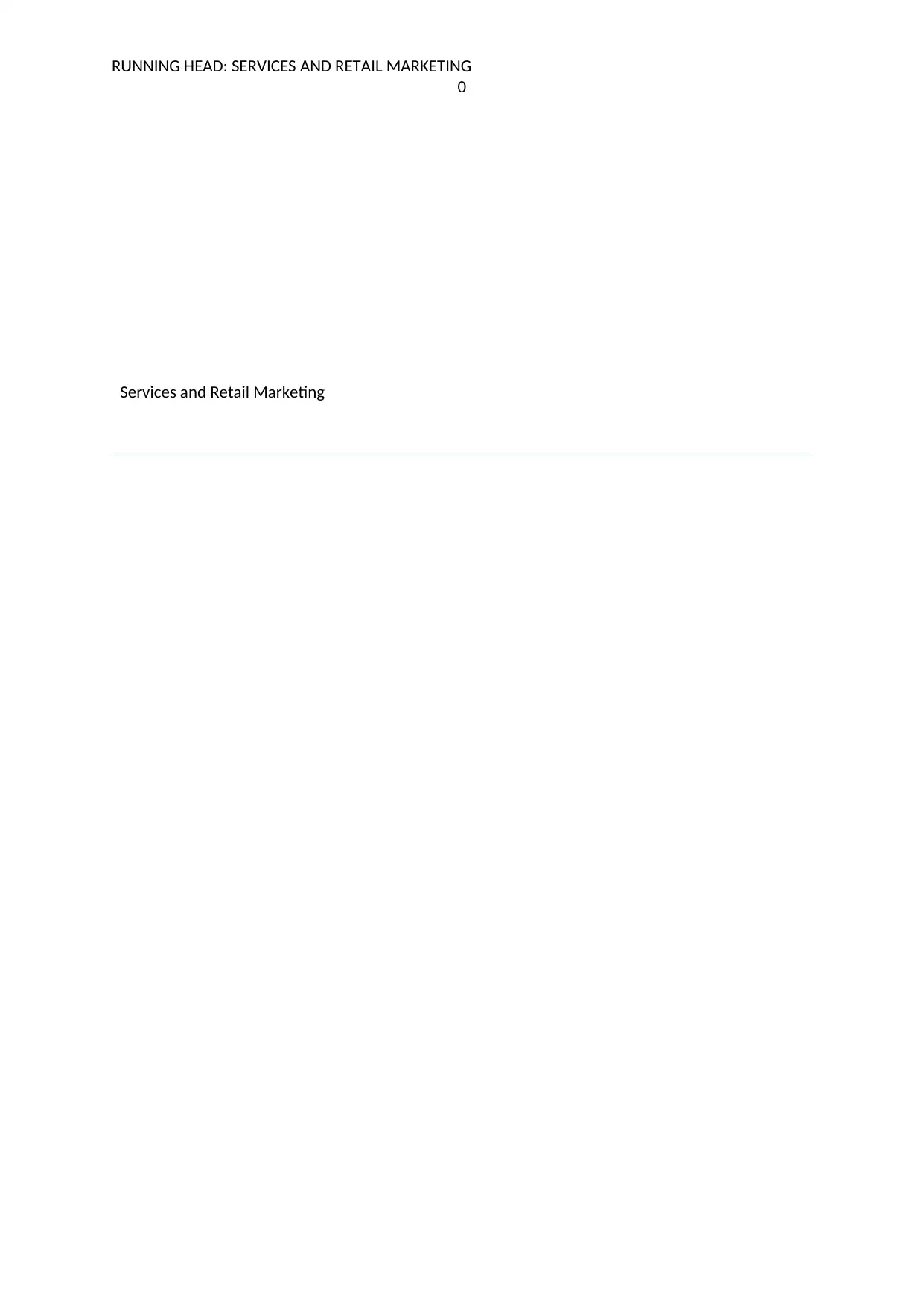
RUNNING HEAD: SERVICES AND RETAIL MARKETING
0
Services and Retail Marketing
0
Services and Retail Marketing
Paraphrase This Document
Need a fresh take? Get an instant paraphrase of this document with our AI Paraphraser
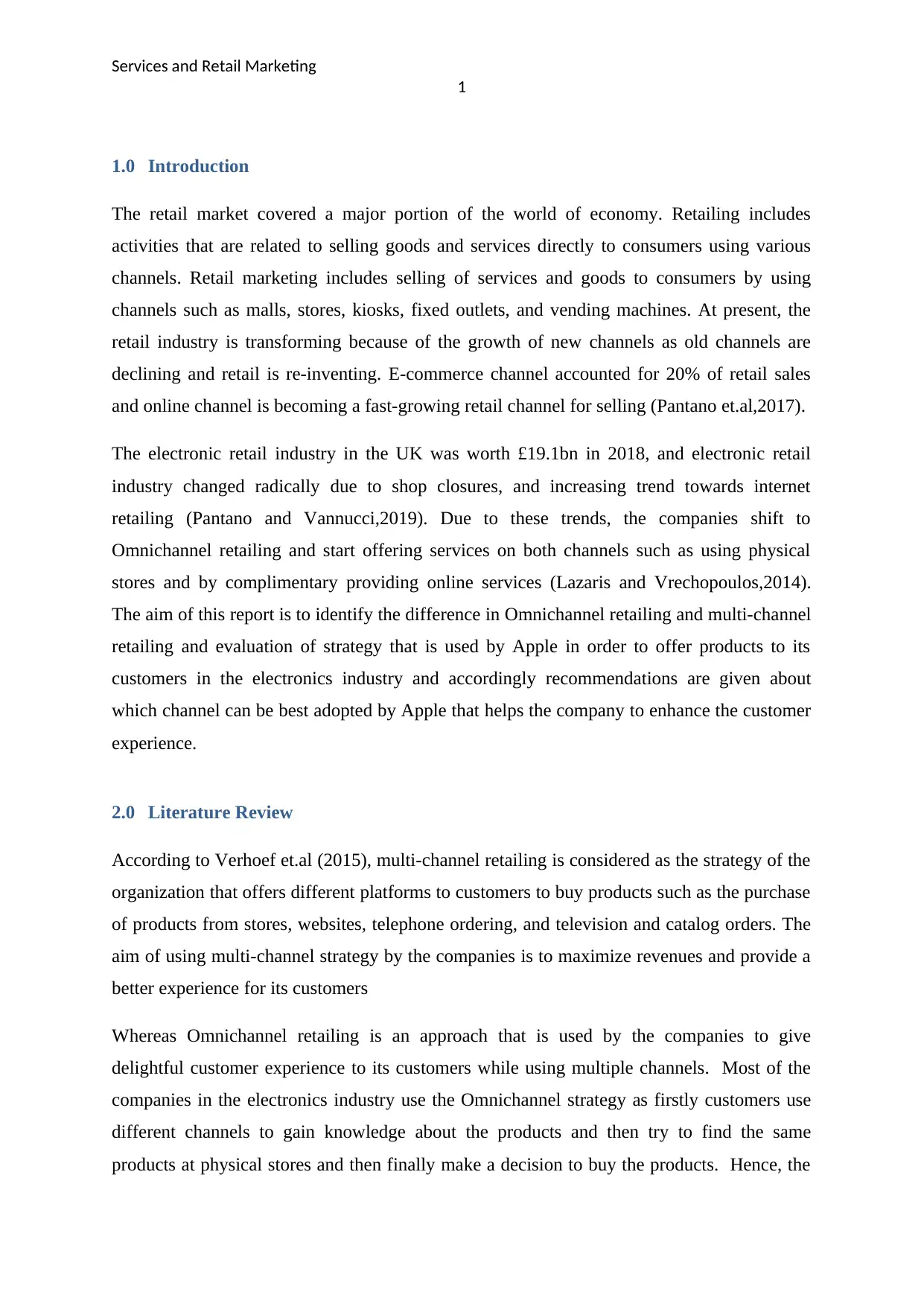
Services and Retail Marketing
1
1.0 Introduction
The retail market covered a major portion of the world of economy. Retailing includes
activities that are related to selling goods and services directly to consumers using various
channels. Retail marketing includes selling of services and goods to consumers by using
channels such as malls, stores, kiosks, fixed outlets, and vending machines. At present, the
retail industry is transforming because of the growth of new channels as old channels are
declining and retail is re-inventing. E-commerce channel accounted for 20% of retail sales
and online channel is becoming a fast-growing retail channel for selling (Pantano et.al,2017).
The electronic retail industry in the UK was worth £19.1bn in 2018, and electronic retail
industry changed radically due to shop closures, and increasing trend towards internet
retailing (Pantano and Vannucci,2019). Due to these trends, the companies shift to
Omnichannel retailing and start offering services on both channels such as using physical
stores and by complimentary providing online services (Lazaris and Vrechopoulos,2014).
The aim of this report is to identify the difference in Omnichannel retailing and multi-channel
retailing and evaluation of strategy that is used by Apple in order to offer products to its
customers in the electronics industry and accordingly recommendations are given about
which channel can be best adopted by Apple that helps the company to enhance the customer
experience.
2.0 Literature Review
According to Verhoef et.al (2015), multi-channel retailing is considered as the strategy of the
organization that offers different platforms to customers to buy products such as the purchase
of products from stores, websites, telephone ordering, and television and catalog orders. The
aim of using multi-channel strategy by the companies is to maximize revenues and provide a
better experience for its customers
Whereas Omnichannel retailing is an approach that is used by the companies to give
delightful customer experience to its customers while using multiple channels. Most of the
companies in the electronics industry use the Omnichannel strategy as firstly customers use
different channels to gain knowledge about the products and then try to find the same
products at physical stores and then finally make a decision to buy the products. Hence, the
1
1.0 Introduction
The retail market covered a major portion of the world of economy. Retailing includes
activities that are related to selling goods and services directly to consumers using various
channels. Retail marketing includes selling of services and goods to consumers by using
channels such as malls, stores, kiosks, fixed outlets, and vending machines. At present, the
retail industry is transforming because of the growth of new channels as old channels are
declining and retail is re-inventing. E-commerce channel accounted for 20% of retail sales
and online channel is becoming a fast-growing retail channel for selling (Pantano et.al,2017).
The electronic retail industry in the UK was worth £19.1bn in 2018, and electronic retail
industry changed radically due to shop closures, and increasing trend towards internet
retailing (Pantano and Vannucci,2019). Due to these trends, the companies shift to
Omnichannel retailing and start offering services on both channels such as using physical
stores and by complimentary providing online services (Lazaris and Vrechopoulos,2014).
The aim of this report is to identify the difference in Omnichannel retailing and multi-channel
retailing and evaluation of strategy that is used by Apple in order to offer products to its
customers in the electronics industry and accordingly recommendations are given about
which channel can be best adopted by Apple that helps the company to enhance the customer
experience.
2.0 Literature Review
According to Verhoef et.al (2015), multi-channel retailing is considered as the strategy of the
organization that offers different platforms to customers to buy products such as the purchase
of products from stores, websites, telephone ordering, and television and catalog orders. The
aim of using multi-channel strategy by the companies is to maximize revenues and provide a
better experience for its customers
Whereas Omnichannel retailing is an approach that is used by the companies to give
delightful customer experience to its customers while using multiple channels. Most of the
companies in the electronics industry use the Omnichannel strategy as firstly customers use
different channels to gain knowledge about the products and then try to find the same
products at physical stores and then finally make a decision to buy the products. Hence, the
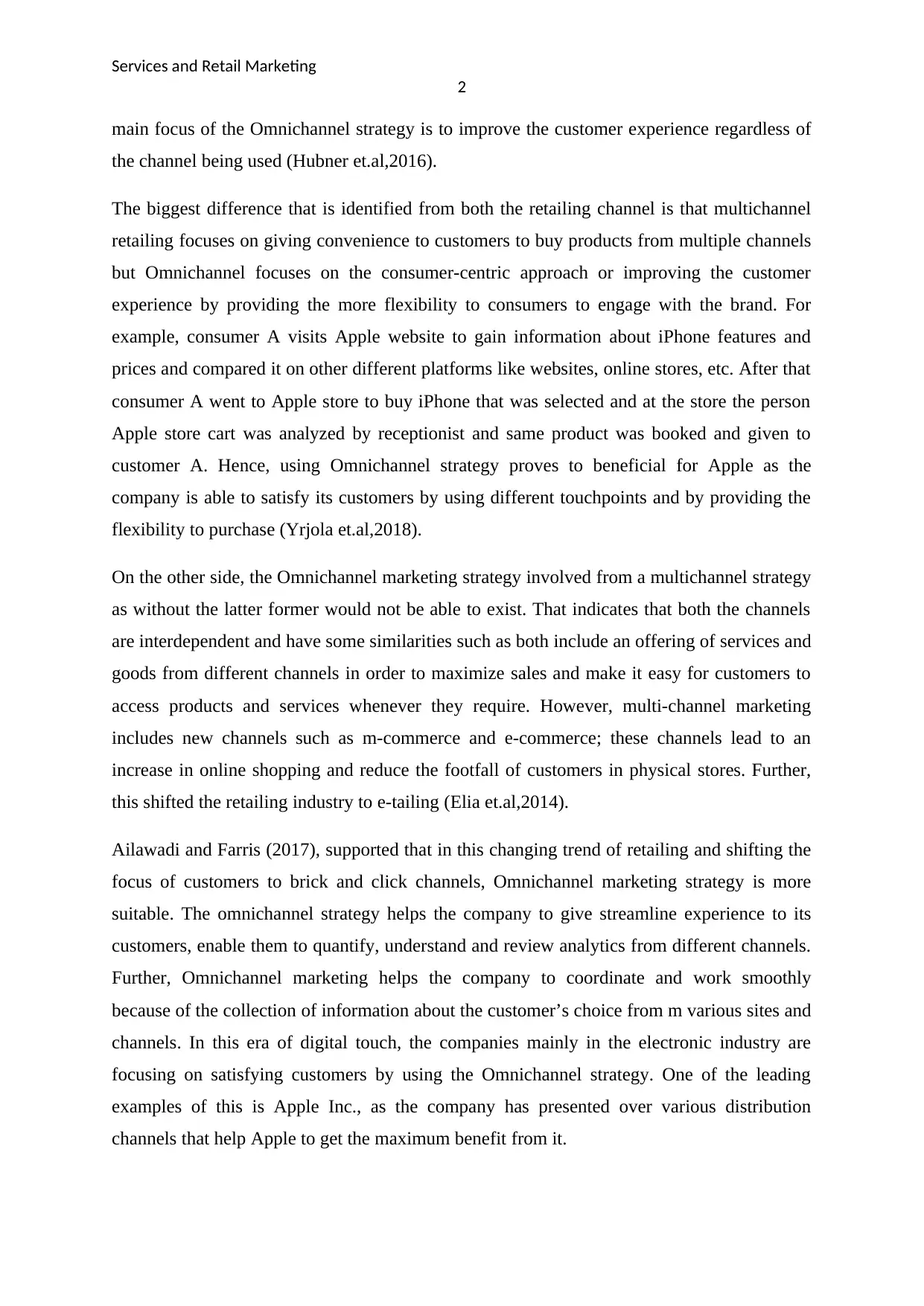
Services and Retail Marketing
2
main focus of the Omnichannel strategy is to improve the customer experience regardless of
the channel being used (Hubner et.al,2016).
The biggest difference that is identified from both the retailing channel is that multichannel
retailing focuses on giving convenience to customers to buy products from multiple channels
but Omnichannel focuses on the consumer-centric approach or improving the customer
experience by providing the more flexibility to consumers to engage with the brand. For
example, consumer A visits Apple website to gain information about iPhone features and
prices and compared it on other different platforms like websites, online stores, etc. After that
consumer A went to Apple store to buy iPhone that was selected and at the store the person
Apple store cart was analyzed by receptionist and same product was booked and given to
customer A. Hence, using Omnichannel strategy proves to beneficial for Apple as the
company is able to satisfy its customers by using different touchpoints and by providing the
flexibility to purchase (Yrjola et.al,2018).
On the other side, the Omnichannel marketing strategy involved from a multichannel strategy
as without the latter former would not be able to exist. That indicates that both the channels
are interdependent and have some similarities such as both include an offering of services and
goods from different channels in order to maximize sales and make it easy for customers to
access products and services whenever they require. However, multi-channel marketing
includes new channels such as m-commerce and e-commerce; these channels lead to an
increase in online shopping and reduce the footfall of customers in physical stores. Further,
this shifted the retailing industry to e-tailing (Elia et.al,2014).
Ailawadi and Farris (2017), supported that in this changing trend of retailing and shifting the
focus of customers to brick and click channels, Omnichannel marketing strategy is more
suitable. The omnichannel strategy helps the company to give streamline experience to its
customers, enable them to quantify, understand and review analytics from different channels.
Further, Omnichannel marketing helps the company to coordinate and work smoothly
because of the collection of information about the customer’s choice from m various sites and
channels. In this era of digital touch, the companies mainly in the electronic industry are
focusing on satisfying customers by using the Omnichannel strategy. One of the leading
examples of this is Apple Inc., as the company has presented over various distribution
channels that help Apple to get the maximum benefit from it.
2
main focus of the Omnichannel strategy is to improve the customer experience regardless of
the channel being used (Hubner et.al,2016).
The biggest difference that is identified from both the retailing channel is that multichannel
retailing focuses on giving convenience to customers to buy products from multiple channels
but Omnichannel focuses on the consumer-centric approach or improving the customer
experience by providing the more flexibility to consumers to engage with the brand. For
example, consumer A visits Apple website to gain information about iPhone features and
prices and compared it on other different platforms like websites, online stores, etc. After that
consumer A went to Apple store to buy iPhone that was selected and at the store the person
Apple store cart was analyzed by receptionist and same product was booked and given to
customer A. Hence, using Omnichannel strategy proves to beneficial for Apple as the
company is able to satisfy its customers by using different touchpoints and by providing the
flexibility to purchase (Yrjola et.al,2018).
On the other side, the Omnichannel marketing strategy involved from a multichannel strategy
as without the latter former would not be able to exist. That indicates that both the channels
are interdependent and have some similarities such as both include an offering of services and
goods from different channels in order to maximize sales and make it easy for customers to
access products and services whenever they require. However, multi-channel marketing
includes new channels such as m-commerce and e-commerce; these channels lead to an
increase in online shopping and reduce the footfall of customers in physical stores. Further,
this shifted the retailing industry to e-tailing (Elia et.al,2014).
Ailawadi and Farris (2017), supported that in this changing trend of retailing and shifting the
focus of customers to brick and click channels, Omnichannel marketing strategy is more
suitable. The omnichannel strategy helps the company to give streamline experience to its
customers, enable them to quantify, understand and review analytics from different channels.
Further, Omnichannel marketing helps the company to coordinate and work smoothly
because of the collection of information about the customer’s choice from m various sites and
channels. In this era of digital touch, the companies mainly in the electronic industry are
focusing on satisfying customers by using the Omnichannel strategy. One of the leading
examples of this is Apple Inc., as the company has presented over various distribution
channels that help Apple to get the maximum benefit from it.
⊘ This is a preview!⊘
Do you want full access?
Subscribe today to unlock all pages.

Trusted by 1+ million students worldwide
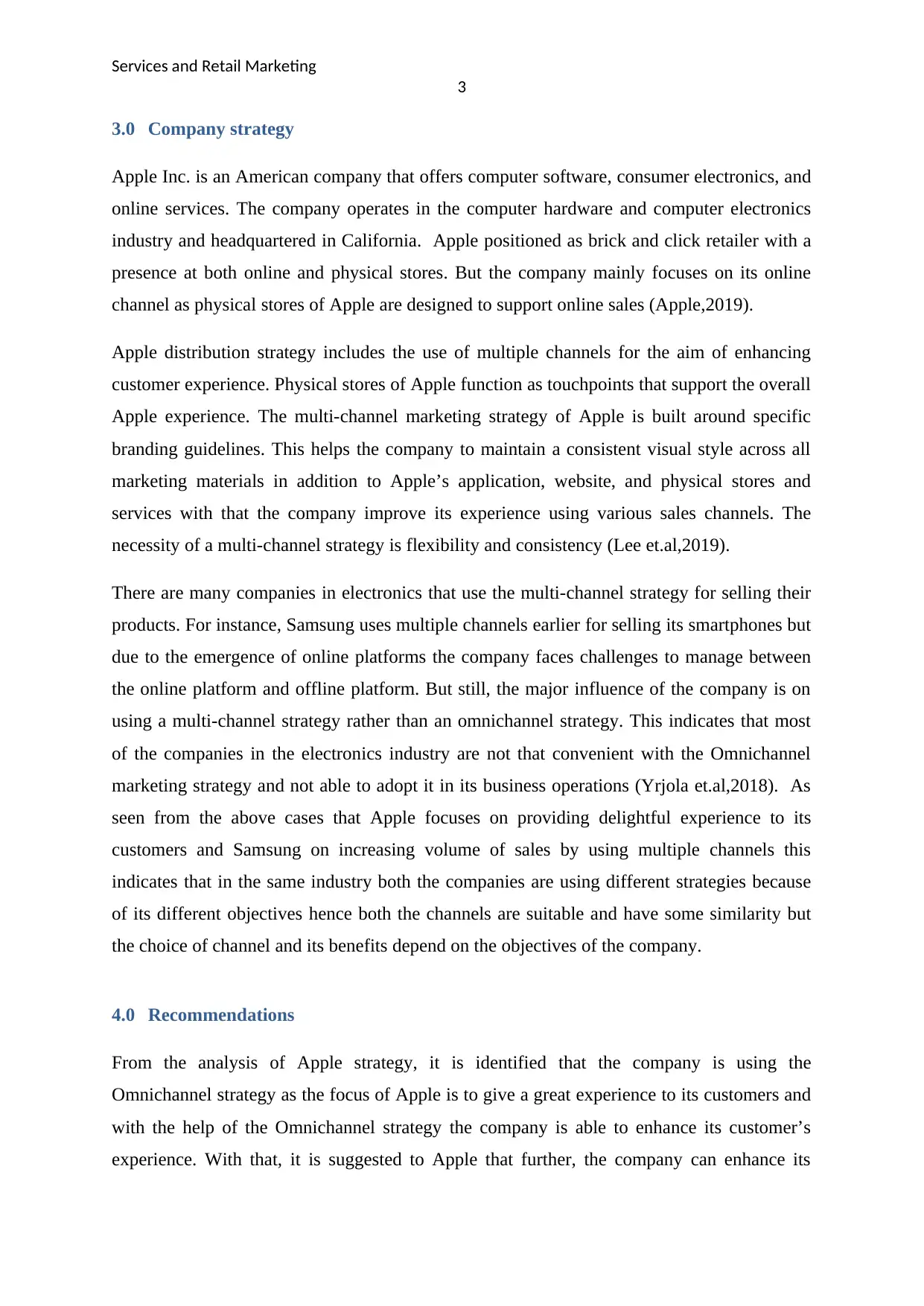
Services and Retail Marketing
3
3.0 Company strategy
Apple Inc. is an American company that offers computer software, consumer electronics, and
online services. The company operates in the computer hardware and computer electronics
industry and headquartered in California. Apple positioned as brick and click retailer with a
presence at both online and physical stores. But the company mainly focuses on its online
channel as physical stores of Apple are designed to support online sales (Apple,2019).
Apple distribution strategy includes the use of multiple channels for the aim of enhancing
customer experience. Physical stores of Apple function as touchpoints that support the overall
Apple experience. The multi-channel marketing strategy of Apple is built around specific
branding guidelines. This helps the company to maintain a consistent visual style across all
marketing materials in addition to Apple’s application, website, and physical stores and
services with that the company improve its experience using various sales channels. The
necessity of a multi-channel strategy is flexibility and consistency (Lee et.al,2019).
There are many companies in electronics that use the multi-channel strategy for selling their
products. For instance, Samsung uses multiple channels earlier for selling its smartphones but
due to the emergence of online platforms the company faces challenges to manage between
the online platform and offline platform. But still, the major influence of the company is on
using a multi-channel strategy rather than an omnichannel strategy. This indicates that most
of the companies in the electronics industry are not that convenient with the Omnichannel
marketing strategy and not able to adopt it in its business operations (Yrjola et.al,2018). As
seen from the above cases that Apple focuses on providing delightful experience to its
customers and Samsung on increasing volume of sales by using multiple channels this
indicates that in the same industry both the companies are using different strategies because
of its different objectives hence both the channels are suitable and have some similarity but
the choice of channel and its benefits depend on the objectives of the company.
4.0 Recommendations
From the analysis of Apple strategy, it is identified that the company is using the
Omnichannel strategy as the focus of Apple is to give a great experience to its customers and
with the help of the Omnichannel strategy the company is able to enhance its customer’s
experience. With that, it is suggested to Apple that further, the company can enhance its
3
3.0 Company strategy
Apple Inc. is an American company that offers computer software, consumer electronics, and
online services. The company operates in the computer hardware and computer electronics
industry and headquartered in California. Apple positioned as brick and click retailer with a
presence at both online and physical stores. But the company mainly focuses on its online
channel as physical stores of Apple are designed to support online sales (Apple,2019).
Apple distribution strategy includes the use of multiple channels for the aim of enhancing
customer experience. Physical stores of Apple function as touchpoints that support the overall
Apple experience. The multi-channel marketing strategy of Apple is built around specific
branding guidelines. This helps the company to maintain a consistent visual style across all
marketing materials in addition to Apple’s application, website, and physical stores and
services with that the company improve its experience using various sales channels. The
necessity of a multi-channel strategy is flexibility and consistency (Lee et.al,2019).
There are many companies in electronics that use the multi-channel strategy for selling their
products. For instance, Samsung uses multiple channels earlier for selling its smartphones but
due to the emergence of online platforms the company faces challenges to manage between
the online platform and offline platform. But still, the major influence of the company is on
using a multi-channel strategy rather than an omnichannel strategy. This indicates that most
of the companies in the electronics industry are not that convenient with the Omnichannel
marketing strategy and not able to adopt it in its business operations (Yrjola et.al,2018). As
seen from the above cases that Apple focuses on providing delightful experience to its
customers and Samsung on increasing volume of sales by using multiple channels this
indicates that in the same industry both the companies are using different strategies because
of its different objectives hence both the channels are suitable and have some similarity but
the choice of channel and its benefits depend on the objectives of the company.
4.0 Recommendations
From the analysis of Apple strategy, it is identified that the company is using the
Omnichannel strategy as the focus of Apple is to give a great experience to its customers and
with the help of the Omnichannel strategy the company is able to enhance its customer’s
experience. With that, it is suggested to Apple that further, the company can enhance its
Paraphrase This Document
Need a fresh take? Get an instant paraphrase of this document with our AI Paraphraser
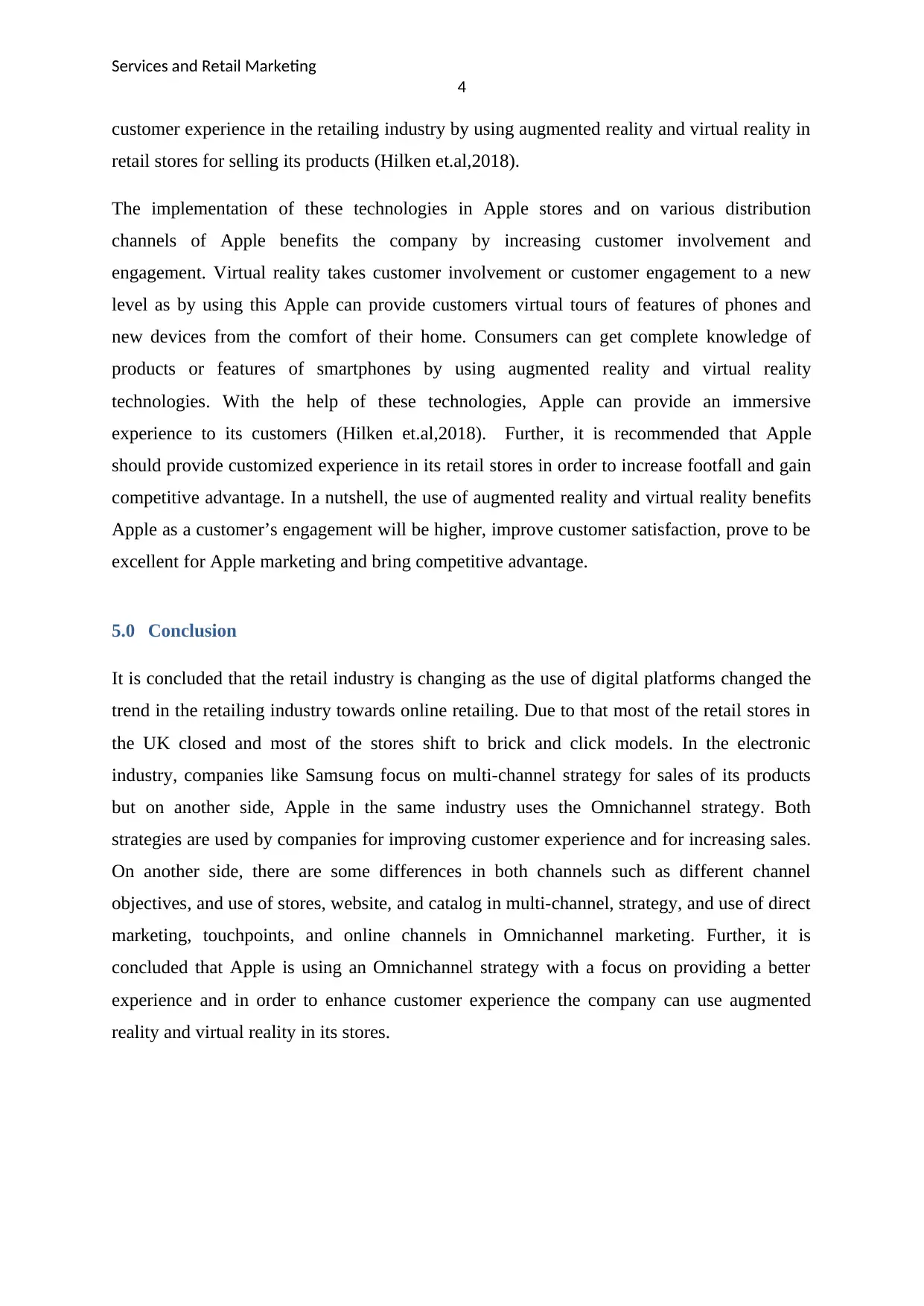
Services and Retail Marketing
4
customer experience in the retailing industry by using augmented reality and virtual reality in
retail stores for selling its products (Hilken et.al,2018).
The implementation of these technologies in Apple stores and on various distribution
channels of Apple benefits the company by increasing customer involvement and
engagement. Virtual reality takes customer involvement or customer engagement to a new
level as by using this Apple can provide customers virtual tours of features of phones and
new devices from the comfort of their home. Consumers can get complete knowledge of
products or features of smartphones by using augmented reality and virtual reality
technologies. With the help of these technologies, Apple can provide an immersive
experience to its customers (Hilken et.al,2018). Further, it is recommended that Apple
should provide customized experience in its retail stores in order to increase footfall and gain
competitive advantage. In a nutshell, the use of augmented reality and virtual reality benefits
Apple as a customer’s engagement will be higher, improve customer satisfaction, prove to be
excellent for Apple marketing and bring competitive advantage.
5.0 Conclusion
It is concluded that the retail industry is changing as the use of digital platforms changed the
trend in the retailing industry towards online retailing. Due to that most of the retail stores in
the UK closed and most of the stores shift to brick and click models. In the electronic
industry, companies like Samsung focus on multi-channel strategy for sales of its products
but on another side, Apple in the same industry uses the Omnichannel strategy. Both
strategies are used by companies for improving customer experience and for increasing sales.
On another side, there are some differences in both channels such as different channel
objectives, and use of stores, website, and catalog in multi-channel, strategy, and use of direct
marketing, touchpoints, and online channels in Omnichannel marketing. Further, it is
concluded that Apple is using an Omnichannel strategy with a focus on providing a better
experience and in order to enhance customer experience the company can use augmented
reality and virtual reality in its stores.
4
customer experience in the retailing industry by using augmented reality and virtual reality in
retail stores for selling its products (Hilken et.al,2018).
The implementation of these technologies in Apple stores and on various distribution
channels of Apple benefits the company by increasing customer involvement and
engagement. Virtual reality takes customer involvement or customer engagement to a new
level as by using this Apple can provide customers virtual tours of features of phones and
new devices from the comfort of their home. Consumers can get complete knowledge of
products or features of smartphones by using augmented reality and virtual reality
technologies. With the help of these technologies, Apple can provide an immersive
experience to its customers (Hilken et.al,2018). Further, it is recommended that Apple
should provide customized experience in its retail stores in order to increase footfall and gain
competitive advantage. In a nutshell, the use of augmented reality and virtual reality benefits
Apple as a customer’s engagement will be higher, improve customer satisfaction, prove to be
excellent for Apple marketing and bring competitive advantage.
5.0 Conclusion
It is concluded that the retail industry is changing as the use of digital platforms changed the
trend in the retailing industry towards online retailing. Due to that most of the retail stores in
the UK closed and most of the stores shift to brick and click models. In the electronic
industry, companies like Samsung focus on multi-channel strategy for sales of its products
but on another side, Apple in the same industry uses the Omnichannel strategy. Both
strategies are used by companies for improving customer experience and for increasing sales.
On another side, there are some differences in both channels such as different channel
objectives, and use of stores, website, and catalog in multi-channel, strategy, and use of direct
marketing, touchpoints, and online channels in Omnichannel marketing. Further, it is
concluded that Apple is using an Omnichannel strategy with a focus on providing a better
experience and in order to enhance customer experience the company can use augmented
reality and virtual reality in its stores.
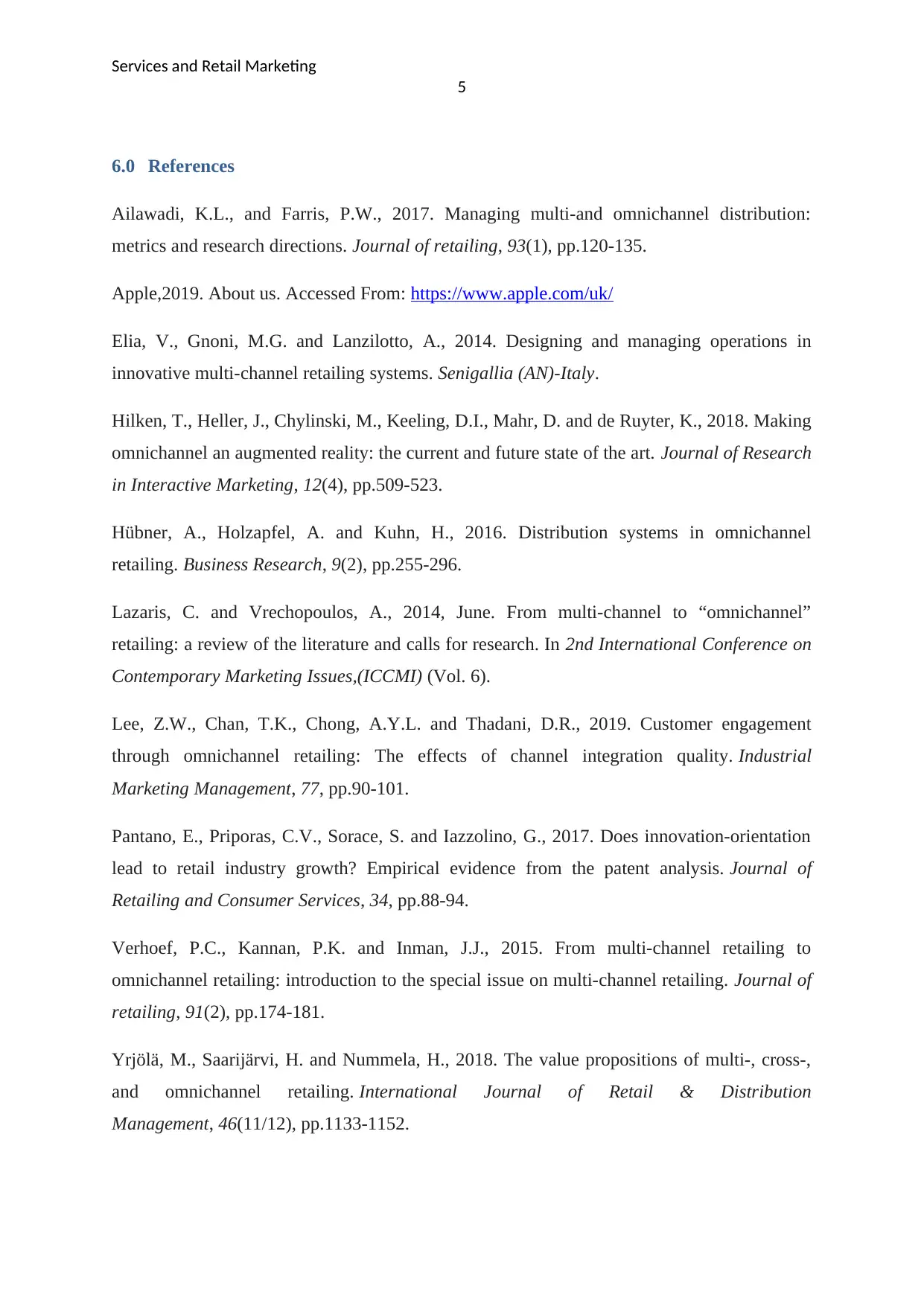
Services and Retail Marketing
5
6.0 References
Ailawadi, K.L., and Farris, P.W., 2017. Managing multi-and omnichannel distribution:
metrics and research directions. Journal of retailing, 93(1), pp.120-135.
Apple,2019. About us. Accessed From: https://www.apple.com/uk/
Elia, V., Gnoni, M.G. and Lanzilotto, A., 2014. Designing and managing operations in
innovative multi-channel retailing systems. Senigallia (AN)-Italy.
Hilken, T., Heller, J., Chylinski, M., Keeling, D.I., Mahr, D. and de Ruyter, K., 2018. Making
omnichannel an augmented reality: the current and future state of the art. Journal of Research
in Interactive Marketing, 12(4), pp.509-523.
Hübner, A., Holzapfel, A. and Kuhn, H., 2016. Distribution systems in omnichannel
retailing. Business Research, 9(2), pp.255-296.
Lazaris, C. and Vrechopoulos, A., 2014, June. From multi-channel to “omnichannel”
retailing: a review of the literature and calls for research. In 2nd International Conference on
Contemporary Marketing Issues,(ICCMI) (Vol. 6).
Lee, Z.W., Chan, T.K., Chong, A.Y.L. and Thadani, D.R., 2019. Customer engagement
through omnichannel retailing: The effects of channel integration quality. Industrial
Marketing Management, 77, pp.90-101.
Pantano, E., Priporas, C.V., Sorace, S. and Iazzolino, G., 2017. Does innovation-orientation
lead to retail industry growth? Empirical evidence from the patent analysis. Journal of
Retailing and Consumer Services, 34, pp.88-94.
Verhoef, P.C., Kannan, P.K. and Inman, J.J., 2015. From multi-channel retailing to
omnichannel retailing: introduction to the special issue on multi-channel retailing. Journal of
retailing, 91(2), pp.174-181.
Yrjölä, M., Saarijärvi, H. and Nummela, H., 2018. The value propositions of multi-, cross-,
and omnichannel retailing. International Journal of Retail & Distribution
Management, 46(11/12), pp.1133-1152.
5
6.0 References
Ailawadi, K.L., and Farris, P.W., 2017. Managing multi-and omnichannel distribution:
metrics and research directions. Journal of retailing, 93(1), pp.120-135.
Apple,2019. About us. Accessed From: https://www.apple.com/uk/
Elia, V., Gnoni, M.G. and Lanzilotto, A., 2014. Designing and managing operations in
innovative multi-channel retailing systems. Senigallia (AN)-Italy.
Hilken, T., Heller, J., Chylinski, M., Keeling, D.I., Mahr, D. and de Ruyter, K., 2018. Making
omnichannel an augmented reality: the current and future state of the art. Journal of Research
in Interactive Marketing, 12(4), pp.509-523.
Hübner, A., Holzapfel, A. and Kuhn, H., 2016. Distribution systems in omnichannel
retailing. Business Research, 9(2), pp.255-296.
Lazaris, C. and Vrechopoulos, A., 2014, June. From multi-channel to “omnichannel”
retailing: a review of the literature and calls for research. In 2nd International Conference on
Contemporary Marketing Issues,(ICCMI) (Vol. 6).
Lee, Z.W., Chan, T.K., Chong, A.Y.L. and Thadani, D.R., 2019. Customer engagement
through omnichannel retailing: The effects of channel integration quality. Industrial
Marketing Management, 77, pp.90-101.
Pantano, E., Priporas, C.V., Sorace, S. and Iazzolino, G., 2017. Does innovation-orientation
lead to retail industry growth? Empirical evidence from the patent analysis. Journal of
Retailing and Consumer Services, 34, pp.88-94.
Verhoef, P.C., Kannan, P.K. and Inman, J.J., 2015. From multi-channel retailing to
omnichannel retailing: introduction to the special issue on multi-channel retailing. Journal of
retailing, 91(2), pp.174-181.
Yrjölä, M., Saarijärvi, H. and Nummela, H., 2018. The value propositions of multi-, cross-,
and omnichannel retailing. International Journal of Retail & Distribution
Management, 46(11/12), pp.1133-1152.
⊘ This is a preview!⊘
Do you want full access?
Subscribe today to unlock all pages.

Trusted by 1+ million students worldwide
1 out of 6
Related Documents
Your All-in-One AI-Powered Toolkit for Academic Success.
+13062052269
info@desklib.com
Available 24*7 on WhatsApp / Email
![[object Object]](/_next/static/media/star-bottom.7253800d.svg)
Unlock your academic potential
Copyright © 2020–2025 A2Z Services. All Rights Reserved. Developed and managed by ZUCOL.





